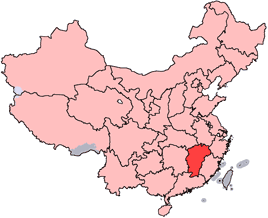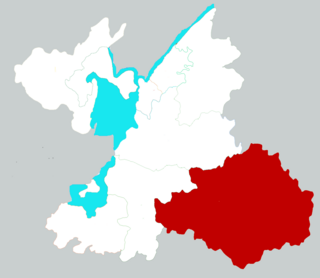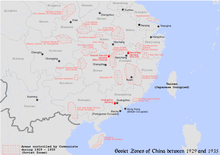The encirclement campaigns of the Chinese Civil War were Republic of China (ROC) offensives against Chinese Communist Party (CCP) revolutionary base areas in China from the late-1920s to 1934 during the Chinese Civil War.
The Campaign to Suppress Nationalists in Northeastern Guizhou (黔东北剿匪) was a counter-guerrilla / counterinsurgency campaign the communists fought against the nationalist guerrilla that was mostly consisted of bandits and nationalist regular troops left behind after the nationalist regime withdrew from mainland China. The campaign was part of the Chinese Civil War in the post–World War II era fought in northeastern Guizhou, and resulted in communist victory. This campaign is a major part of Campaign to Suppress Bandits in Southwestern China during the Chinese Civil War in the post–World War II era.
Campaign to Suppress Bandits in the Border Region of the Hubei-Hunan-Sichuan (湘鄂川边剿匪) was a counter-guerrilla/counterinsurgency campaign that the Communists fought against the Kuomintang guerrilla left behind after the nationalist government withdrew from mainland China. The campaign was actually fought after the Chinese Civil War was declared over by the PRC in Beijing a year earlier, and took place in the border regions of the following three Chinese provinces: Hubei, Hunan, and Sichuan, and resulted in communist victory. This campaign was part of Campaign to Suppress Bandits in Central and Southern China.

The encirclement campaign against the Northeastern Jiangxi Soviet was a campaign launched by the Chinese Nationalist Government intended to destroy the communist Chinese Soviet Republic and its local military forces. It was met by the Communists' Counter-encirclement campaign at Northeastern Jiangxi Soviet, also called the Counter-encirclement campaign at Northeastern Jiangxi Revolutionary Base. The Nationalist campaign lasted from December 1930 to July 1931, and resulted in the destruction of the target base area.

The second encirclement campaign against the Shaanxi–Gansu Soviet was an encirclement campaign launched by the Chinese Nationalist government that was intended to destroy the Communist Shaanxi–Gansu Soviet and its Chinese Red Army in the local region. It was responded by the Communists' second counter-encirclement campaign at Shaanxi–Gansu Soviet, also called by the Communists as the second counter-encirclement campaign at Shaanxi–Gansu Revolutionary Base, in which the local Chinese Red Army successfully defended their soviet republic in the border region of Shaanxi and Gansu provinces against the Nationalist attacks from April 1935 to July 1935.
The first encirclement campaign against the Shaanxi–Gansu Soviet was an encirclement campaign launched by the Chinese Nationalist Government that was intended to destroy the communist Shaanxi–Gansu Soviet and its Chinese Red Army in the local region. It was responded by the Communists' first counter-encirclement campaign at Shaanxi–Gansu Soviet, also called by the communists as the first counter-encirclement campaign at Shaanxi–Gansu Revolutionary Base, in which the local Chinese Red Army successfully defended their soviet republic in Shaanxi and Gansu provinces against the Nationalist attacks from March 1934 to 26 August 1934.
The first encirclement campaign against the Hubei–Henan–Shaanxi Soviet was an encirclement campaign launched by the Nationalist Government of China against the Communist Party's Hubei–Henan–Shaanxi Soviet and its local Red Army. The Red Army successfully defended the Soviet against Nationalist attacks from January to February 5, 1935.

The first encirclement campaignagainst Jiangxi Soviet was a series of battles launched by the Chinese Nationalist Government intended to annihilate the Chinese Red Army, and destroy the Soviet. The communists later responded with the first counter-encirclement campaign at Central Soviet, also called by the communists as the first counter-encirclement campaign at Central Revolutionary Base, in which the Red Army successfully defended the Soviet Zone in the southern Jiangxi province against Nationalist attacks from November 1930 to January 3, 1931.

The second encirclement campaignagainst Jiangxi Soviet was a series of battles launched by the Chinese Nationalist Government in the hope of encircling and destroying the Jiangxi Soviet after the previous campaign had failed. The Red Army repelled the encirclement by launching their second counter-encirclement campaign, also called by the communists as the second counter-encirclement campaign at Central Revolutionary Base, in which the local Chinese Red Army successfully defended the Jiangxi Soviet against the Nationalist attacks from April 1, 1931, to May 31, 1931.

The third encirclement campaignagainst Jiangxi Soviet was the third campaign launched by the Chinese Nationalist Government in the hope of destroying the Red Army in Jiangxi. It was launched less than a month after the previous campaign failed. However, this encirclement was repelled by the Red Army's third counter-encirclement campaign at the Central Soviet, also called as the third counter-encirclement campaign at the Central Revolutionary Base.

The fourth encirclement campaign against the Jiangxi Soviet was the fourth campaign launched by the Chinese Nationalist Government in hope to destroy the Red Army in Jiangxi. The Nationalist headquarters in the provincial border of Jiangxi-Guangdong-Fujian organized nearly 400,000 men, and prepared for another major encirclement on the Chinese Soviet Republic. As a response, the Jiangxi Soviet launched the fourth counter-encirclement campaign at the Central Soviet, also called as the fourth counter-encirclement campaign at the Central Revolutionary Base. Although the Red Army achieved victory once again, their counter encirclement was not as successful as the previous ones this time, and the Red Army elsewhere suffered considerable loss when many other Communist bases were lost, including two major ones.
The encirclement campaign against the Hunan-Jiangxi Soviet was an encirclement campaign launched by the Nationalist government against the Communist Party of China's Hunan-Jiangxi Soviet. The Chinese Red Army successfully defended the Soviet against the Nationalist attacks from January 29 to March 24, 1931.

The encirclement campaign against the Hunan-Hubei-Jiangxi Soviet was a military campaign launched by the Kuomintang Nationalist Government against the communist Soviet force in the Hunan-Hubei-Jiangxi. It was responded to with the Communists' Counter-encirclement campaign at the Hunan-Hubei-Jiangxi Soviet, also called their Counter-encirclement campaign at the Hunan-Hubei-Jiangxi Revolutionary Base. The local red army successfully defended this soviet republic against the government attacks from December 1930 through to May 1931.
The Hunan–Jiangxi Soviet was a constituent part of the Chinese Soviet Republic, an unrecognised sovereign state that existed from November 1931 to 1935. Before that declaration of overarching statehood, the area was known as the Hunan-Jiangxi Revolutionary Base.

The Hunan–Hubei–Jiangxi Soviet was a Comintern and local communist-led liberated zone in the 1930s south of the Yangtze River, comprising parts of counties in what are now the municipal regions of Yueyang in Hunan, Xianning in Hubei and, in Jiangxi, Jiujiang and Yichun. It was a constituent part of the territorially discontiguous and diplomatically unrecognised Chinese Soviet Republic (CSR). Before the declaration of the CSR in November 1931, the liberated zone had been known to Communists as the Hunan-Hubei-Jiangxi (Xiang-E-Gan) Revolutionary Base Area (湘鄂赣革命根据地).
The Hunan–Hubei–Sichuan–Guizhou Soviet, also spelled as the Hunan–Hupeh–Szechuan-Kweichow Soviet, was a revolutionary base area and constituent part of the Chinese Soviet Republic (1930–1935).

Pingjiang County is a county in the northeast of Hunan province, China. It is the easternmost county-level division of the prefecture-level city of Yueyang.
The third encirclement campaign against the Shaanxi–Gansu Soviet was an encirclement campaign launched by the Chinese Nationalist Government that was intended to destroy the communist Shaanxi–Gansu Soviet and its Chinese Red Army in the local region. It was responded by the Communists' third counter-encirclement campaign at Shaanxi–Gansu Soviet, also called by the communists as the third counter-encirclement campaign at Shaanxi–Gansu Revolutionary Base, in which the local Chinese Red Army successfully defended their soviet republic in the border region of Shaanxi and Gansu provinces against the Nationalist attacks from August 1935 to October 25, 1935. Some Chinese communist historians also consider the Zhiluozhen Campaign fought a month later as part of this third counter-encirclement campaign at Shaanxi–Gansu Soviet.

The fifth encirclement campaign against the Jiangxi Soviet was a series of battles fought during the Chinese Civil War from 25 September 1933, to October 1934 between Chiang Kai-shek's Chinese Nationalists (Kuomintang) and the Chinese Communists. During this campaign, the Kuomintang successfully overran the communist Chinese Soviet Republic and forced the Communists on the run, an event later known as the Long March.

The encirclement campaign against the Hunan–Western Hubei Soviet was an encirclement campaign launched by the Chinese Nationalist Government that was intended to destroy the communist Hunan–Western Hubei Soviet and its Chinese Red Army in the local region. The Communists' responded by launching the Counter-encirclement campaign at Hunan–Western Hubei Soviet, also called by the communists as the Counter-encirclement campaign at Hunan–Western Hubei Revolutionary Base, in which the Nationalist force defeated the local Chinese Red Army and overran the communist base in the southern Hubei and Hunan provinces from November 1930 to January 1931. Since the bulk of the fighting was fought at the second stage of the campaign, concentrated at the heart of the communist base, the Honghu region of Jingzhou, the campaign is therefore also frequently referred as the Fourth encirclement campaign against Honghu Soviet and the Fourth Counter-encirclement campaign at Honghu Revolutionary Base by the communists, or Fourth Counter-encirclement campaign at Honghu Soviet for short.





